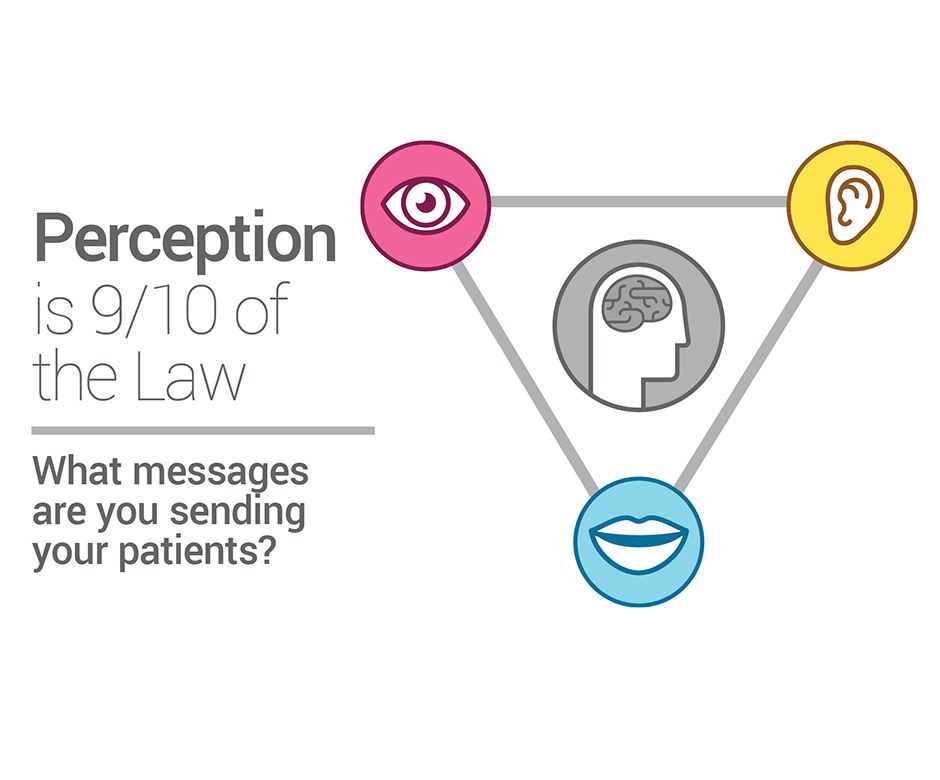Can we talk communication? The kind where you’re not actually talking to the patient but you’re communicating, nonetheless? Your “office” is constantly providing cues to your patients, cues in words they see and hear and ultimately feel, otherwise known as creating perception.
PERCEPTION is 9/10 of the Law!
As soon as patients walk into your office, they observe everything. They see the camaraderie or friction among team members. They notice offers to help one another. They hear how you talk with other patients, including the one you laugh with and the one you console. They see that you love your job. They can tell you love people. They appreciate that you stand up and greet them warmly when they enter the office.
Or is your reception area like a ghost town? Do they hear you say, “You want to reschedule because you have anxiety? Well, what day do you think you’re not gonna have anxiety?” (True story. Can you imagine?)
Next, they ask to use the restroom where they’re alone to look around. What do they see? Dust around the pictures or on those old plastic flowers? Maybe a cobweb here and there? Does someone check periodically throughout the day? Did the last patient leave a slug-shaped bit of toothpaste in the sink? Out of toilet paper or paper towels? They wonder,
“If they can’t take care of their restroom, what about their patients?”
How is that bathroom connected to your patient’s perception? There’s a thought journey attached to everything seen and heard. If something is out of order, people naturally start to wonder about other things in the environment. For example, if the bathroom isn’t up to snuff, they wonder how things are being taken care of in the back.
Once patients are seated in the operatory, they feel and see things from a different perspective. Are they being left unattended? Are you washing your hands at the sink while greeting the patient? Do you talk to them while seated just behind their right ear, so they strain to make eye contact? Are your overhead lights clean and polished? When was the last time you sat in your chairs to see what the patient sees? Are there stains or tears in your chairs? It’s great that you have your name embroidered on your uniforms, but how do those uniforms look? Freshly pressed or rumpled?
At what else should you take a closer look?
Although I worked twenty years in dental offices, I’m a typical patient when sitting in a chair, a little stressed and worried about my treatment. Here’s where perception can make a huge impact. I’ll never forget one time I was having treatment done. Soon after the treatment started, I overheard the following conversation:
Dr. Prins: “Marilee, can you please hand me the…?”
Marilee: “I sure can Dr. Prins. Here you go.”
Dr. Prins: “Thank you, Marilee.”
Marilee: “That’s looking really good, Dr. Prins.”
Dr. Prins: “Yeah, it’s turning out really nice.
Marilee: “I think that shade is perfect. Wow, what a difference!”
When I was a kid, leaving a third person out of a conversation was called “Tea Party” and it was considered rude. I can tell you that being left out of the above conversation was magical. There I was, simply an observer and an eavesdropper, my eyes going back and forth between two people who appeared to be in a world of their own, discussing how well my treatment was going. What I heard brought me an immediate and undeniable sense of comfort and trust in these two individuals, as well as the treatment they were providing. I thought, “These guys are really good! My treatment must be really great!”
Consider the messages you are sending your patients even when you’re not talking to them directly. Their perception of your office environment is huge.
Remember, PERCEPTION is 9/10 of the Law!

Jodie Pearson is a member of the Academy of Dental Management Consultants.
FMI: jodiebill@yahoo.com

